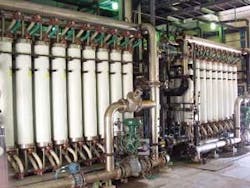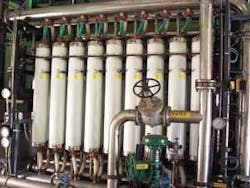Ultrafiltration plant provides reliable water for oil refinery operations
An Indian oil refinery in Chennai reclaims municipal wastewater by using Koch membranes to improve efficiency in reclamation plant.
By whats has face
The Chennai Petroleum Company Limited (CPCL) attributes much of the efficiency and effectiveness of its wastewater reclamation plant to Koch Membrane Systems’ ultrafiltration membrane system. The KMS system pretreats feedwater before it enters the reverse osmosis system.
For years, the Chennai metropolitan area of the Tamil Nadu State of India has suffered from severe water shortages because of below-average annual rainfall. In lieu of adequate rainwater, the city has had to depend on a combination of alternative sources for water, such as surface water run-off, groundwater from aquifers surrounding the city and water from the Krishna River in Andhra Pradesh. To make matters worse, the limited amount of water to which Chennai has access is polluted by sand mining and nearby textile and leather tanning plants.
During the late 1980s Chennai Petroleum Company Limited (CPCL) curtailed its Manali Refinery operations because of the city’s severe shortage of water. Located outside of the city, CPCL depends on water for many of its processing applications. The water shortage in Chennai posed an enormous challenge to the success of CPCL’s business. In order to increase the amount of available water in Chennai, the company’s management team made a significant investment in a new wastewater reclamation plant that would take municipal sewage from the Chennai Metro Water District and render it clean enough for industrial operations in the refinery.
Photo by KMS
The new plant met as much as 40 percent of the total raw water needs of the refinery, resulting in a first-of-its-kind solution for the Asian refinery industry. The new system operated successfully for more than 10 years, and CPCL increased productivity without taking water away from the people of Chennai.
Although CPCL was pleased with its new supply of clean water, the company found the system to be a time-consuming process that required several steps. First, the secondary treated sewage from the Chennai City sewage treatment plant had to be pumped through a three-kilometer pipeline and into a three-million gallon (MG) reservoir. The reservoir, located at the CPCL campus, also collected sewage from the refinery itself. From the reservoir, the treated sewage passed through a biological treatment system and was stored in a 2.5 MG intermediate storage pond. Next, lime was added to the wastewater, after which the sewage underwent another multi-step process of pressure sand filtration, ammonia stripping, break-point chlorination, multi-media gravity filtration and cartridge filtration. A final step of reverse osmosis (RO) removed salts and very small molecular weight organic compounds from the water.
In the late 1990s, CPCL investigated a number of new technologies in order to make improvements to the reclamation plant. CPCL wanted to reduce the number of steps and processes used for effluent pretreatment and extend the expected life of the RO membranes. The company also wanted the existing RO system to operate at a higher efficiency with an increased flux rate.
After a thorough evaluation of solutions, CPCL selected ultrafiltration (UF) hollow fiber membranes from KMS to pretreat the feed water to the plant’s existing RO system. In November 2004, CPCL commissioned its new, pre-assembled UF membrane system, which was designed to remove very small size contaminants in the feed water including nearly all suspended solids, colloidal particles and microorganisms. The goal was to reduce both the turbidity and the silt density index (SDI) and provide a good quality feed to the RO. Doshi Ion Exchange Limited supplied the entire UF system. KMS supplied the hollow fiber UF membrane cartridges, which are an integral part of the system.
One hundred and eight of ten-inch diameter Targa PMC UF membrane cartridges are mounted on six cartridge racks, with 18 cartridges per rack. The cartridges contain polymeric, hollow fiber membranes that have a nominal molecular weight cut-off of 100,000 Dalton, operate over a very wide pH range of 1.5 to 13, and tolerate oxidizing agents including chlorine and peroxide. In addition, UF membranes consistently deliver product water with very low turbidity, less than 0.1 NTU, and an SDI that is less than 2. “The KMS Targa modules were selected because they offered tighter membrane porosity than competitive products,” said Samir Chaubal, regional manager of the Indian subcontinent for the Koch Membrane Systems Division. “They also had a higher membrane area per module, resulting in a smaller system with lower pump capacities. The smaller size helped CPCL minimize the system floor space area, easing floor space constraints in the existing plant.”
With the UF system pretreating the feed water before it enters the RO system, CPCL is operating more efficiently and effectively and RO cleaning cycles have been reduced along with floor space concerns. Also, due to a high level of automation, the UF system requires minimal operator attention. Operating at 90 percent water recovery, the plant production capacity of treated water is 430 m3 per hour, making it the largest wastewater reclamation plant in India.
“The UF membranes gave us everything we expected and more. Working together with KMS and Doshi Ion Exchange, we developed a simpler and more effective process at our facility for the reuse of municipal sewage using KMS ultrafiltration membranes as pretreatment to the RO system. The Targa UF modules are extremely effective and reliable,” said a senior representative for the environment division at CPCL. In December, CPCL certified that the membrane system is meeting performance expectations.
The wastewater treatment plant at CPCL has also, indirectly, made more water available to Chennai’s 4.5 million inhabitants. Additionally, the new reclamation process has prevented any untreated sewage from damaging the environment.
CPCL has been so pleased with the performance of the KMS membranes that it selected 8822XR-400 RO membranes from KMS when it recently upgraded its RO plant. Despite CPCL’s harsh feed water conditions and temperatures, the new membranes are expected to have a life of four to five years, which compares very favorably with the previous supplier’s membranes, which lasted only 16 to 18 months. The 8822XR-400 membranes also require fewer cleaning cycles than the other membranes and produce a higher quality permeate with a lower TDS, even at the low feed water temperature of 35 degrees Celsius.
The better permeate water quality was an especially important factor in selecting the membranes because CPCL has an ion exchange system downstream from the RO plant. Any additional dissolved solids in the RO system permeate would have necessitated more frequent chemical regeneration and higher chemical usage in the downstream ion exchange system. Had it not been for the high quality permeate from the 8822XR-400 RO membranes, CPCL would also have needed to increase the capacity of the ion exchange system, which would have been almost impossible given their space limitations. CPCL is currently examining other areas where UF and RO can be applied in new wastewater reclamation projects.
Author’s note
Samir Chaubal is the regional sales manager for Koch Membrane Systems in India.
Correction:
In the article “Hollow Fiber and Spiral Membranes Recycle Biologically Treated Effluents,” published in the June/July issue of Water & Wastewater International, a caption on page 13 incorrectly identified KMS reverse osmosis pressure vessels that use the TFC-XR reverse osmosis membranes as FEG tubular membranes.
KMS membranes selected for Chinese desalination plant
Koch Membrane Systems, Inc. (KMS) will provide ultrafiltration pretreatment membranes for one of Asia’s largest seawater desalination plants. The system will supply 28,000 m3/day for the reverse osmosis system that will produce boiler make-up at the Liaoning Zhuanghe Power Plant in Liaoning Province, China.
Supplied by Beijing Lucency Enviro-Tech Co., Ltd., the system will feature 200 Targa®-10 cartridges from KMS. The first two trains, with 40 cartridges each, will be commissioned in August 2006, with the remaining three trains commissioned in late 2007.
This plant is a prominent example of China’ strategy to exploit alternative water sources. John Morrison, senior vice president of sales and marketing at KMS, explained: “This large-scale seawater desalination project will serve as a model for addressing China’s serious water shortage. Our Targa UF membranes provide a reliable and cost-effective pretreatment solution for highly-variable and difficult-to-treat seawater RO desalination plants.”
The hollow fiber membrane cartridges have a 10-inch diameter and deliver 60 percent more product water than conventional 8-inch cartridges, resulting in significant cost savings. By using Targa-10 cartridges, system size is significantly reduced because of the additional flow per cartridge. These smaller systems require 50 percent less floor space, resulting in substantial savings in building costs. Additionally, the larger capacity cartridges reduce the number of connections, thereby improving reliability and further lowering costs.
“Once installed, more than 340,000 m3 of water from a variety of sources in China will be treated using our Targa products,” Morrison said. “This UF hollow fiber cartridge has become the standard in China since it was introduced almost three years ago.”
Unlike cartridges that use membranes with larger pores, Targa-10 cartridges feature ultrafiltration membranes that are designed to remove particulates, colloids and other large molecular weight components while reducing turbidity to less than 0.1 NTU. The membranes are made from a KMS-patented polymer that has been used in municipal and industrial water treatment plants around the world for more than a decade.



